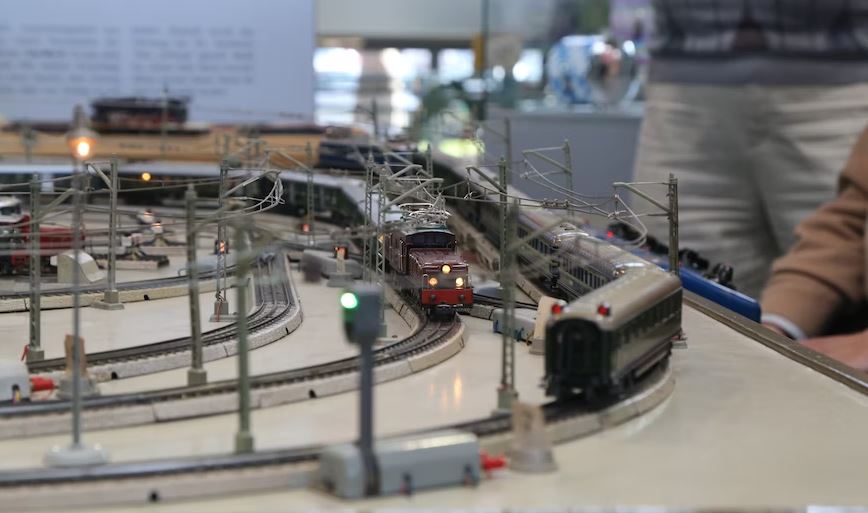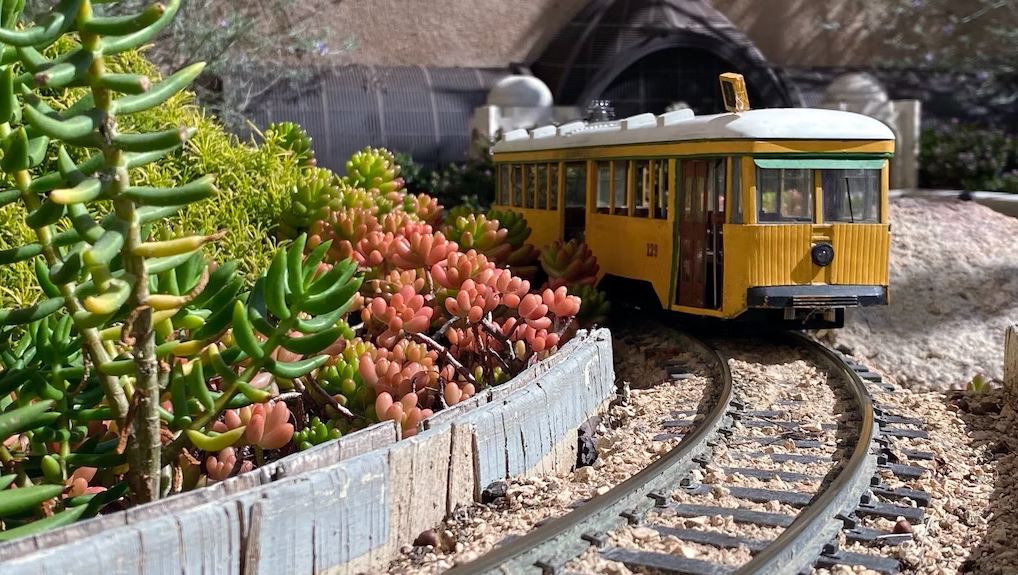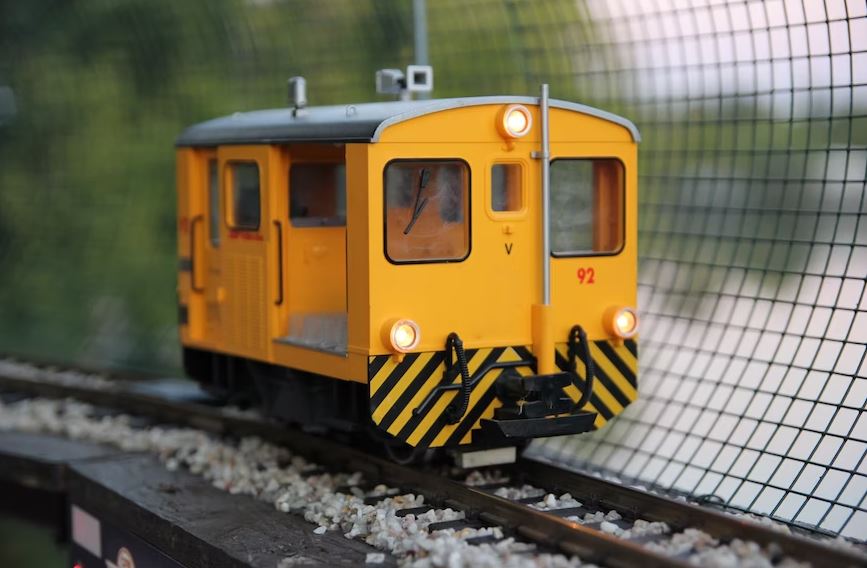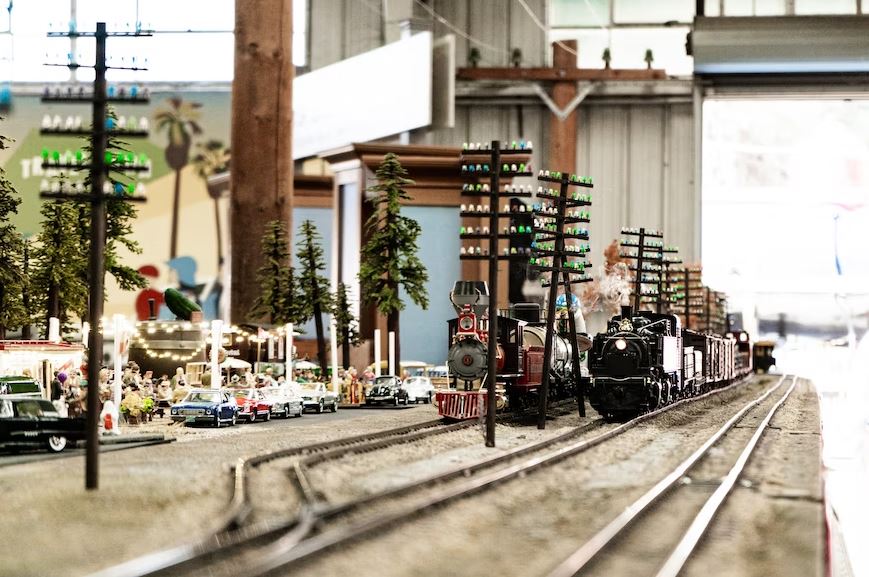Model trains have captured the imaginations of hobbyists for decades. These miniature lifelike trains offer a unique and immersive experience with scenery, intricate details, and realistic sounds. Many enthusiasts find joy in building layouts and collecting locomotives and rolling stock.
However, like any machine, model trains require maintenance to keep them running smoothly. Regular maintenance helps prevent common issues such as derailments and can also extend the lifespan of your collection. In this guide, we’ll discuss the basic, advanced, and preventive maintenance practices that will keep your model trains in excellent condition.
Basic Train Maintenance
If you want your model trains to stay on track and avoid derailments, basic maintenance is essential. Luckily, keeping your trains running smoothly isn’t rocket science. Just focus on a few simple tasks and your trains will keep running for years to come. Here’s what you need to do.
1) Cleaning the train and tracks
With prolonged use, dirt and dust can accumulate on your train and their tracks. Fortunately, it’s easy to address the issue. Use a soft-bristled brush or microfiber cloth to wipe off dust from the train’s exterior. And use a cotton swab to remove debris from those hard-to-reach areas. For the tracks, invest in a track cleaning solution and tool to keep dirt and dust from messing with your train’s performance.
2) Lubricating moving parts
To keep your model train running smoothly, it’s essential to lubricate its moving parts. Take a small amount model train oil or grease and apply it on bearings, axels, and gears. And remember, always follow the manufacturer’s recommendations to avoid any unwanted surprises. When you’re done, wipe off the excess grease to prevent the buildup of dust in the future.
3) Checking for damaged or loose parts
Regularly checking for broken or loose parts is crucial in maintaining your model trains. Wheels and couplers are common culprits, so be vigilant. Promptly replacing them can prevent further damage. Don’t forget to keep spare parts on hand or know where to find them, such as hobby stores or online retailers.
4) Basic troubleshooting techniques
If your model train isn’t running as smooth as it did when you first set it up, try a few troubleshooting tips:
- Check the power source: The power source should be properly connected to provide adequate power to the tracks.
- Evaluate the tracks: It could be that a loose or damaged track section is causing the issue. Make sure there are no problems here. Our post on laying tracks for a model train may help if you’re yet to set the tracks up.
- Inspect the locomotive: The train will stall or run poorly if there are any debris or loose parts. This is why it’s essential to properly lubricate the gears and locomotive wheels.
- Test the couplers: These should be properly aligned and connected. Any discrepancies here may cause your train to derail.
- Try a reset: If you still don’t get optimal performance, remove the train from the track and restart the power source to reboot everything.
Advanced Train Maintenance
If you want level up from basic maintenance (recommended for complex model trains), try these advanced maintenance tips:
1) Upgrading the train’s motor and electronics
The motor and electronics are the core of your train. Upgrading them is an easy way to boost the performance of your model device. Invest in a brushless motor as it’s more powerful and smoother than the brushed varieties. For electronics, your best bet is to get a high-quality DCC (Digital Command Control ) system.
DCC lets you control various accessories and electronics with a single controller. Plus, you get advanced features like realistic deceleration and acceleration.
Of course, the specific electronics and motor you choose depends on your individual preferences. But if you want to enjoy a high-performance train setup, a DCC system along with a brushless motor are a must.
2) Building custom train cars and accessories
Custom train cars and accessories are the perfect way to personalize your model train setup. Beyond the basic car kit, you can unleash your creativity by customizing your train cars with unique designs, decals, and paint jobs.
Build passenger cars with interior details or flatcars to carry cargo. Enhance your train layout with scenery items such as signal towers, stations, and small towns. With endless possibilities, custom-built train cars and accessories will make your setup stand out from the rest.
From designing to constructing, building custom train cars and accessories is a fulfilling process that will elevate your model train game to new heights.
3) Advanced troubleshooting techniques
If you’re facing more complex issues with your model train, try some more advanced troubleshooting techniques:
- If you’re experiencing power loss, check the connections between the tracks and power source. Over time, these connections can loosen or corrode, leading to intermittent power supply. Additionally, inspect the wire connections within the train itself, as any loose or corroded wires can cause power loss as well.
- If your train is derailing frequently, look for any anomalies in the track layout. Small dips, gaps, or unevenness in the track can cause derailments, especially at higher speeds. Additionally, check the wheel flanges for any damage or wear, as this can also cause derailments.
- If you’re experiencing intermittent or unpredictable performance, inspect the locomotive’s gears and motor. Over time, the gears can become worn or misaligned, leading to erratic performance. Similarly, if the motor is overheating or making strange noises, it may be time for a replacement.
Preventive maintenance
Preventive maintenance may sound like a chore, but it’s like insurance for your model train setup. Investing a little time and effort now can save you from future derailments and breakdowns. Here are some preventive maintenance tips to get you going:
Creating a regular maintenance schedule
Creating a regular maintenance schedule is one of the most effective ways to prevent derailments and breakdowns in your model train setup. A typical schedule may include weekly tasks such as inspecting the tracks and electrical connections, as well as monthly tasks such as lubricating moving parts and checking for any damage or wear-and-tear. By scheduling regular cleaning and upkeep tasks, you can ensure that your locomotives and tracks remain in optimal condition.
It’s also important to tailor your maintenance schedule to your specific needs and equipment, as different models may require different levels of care. Remember, a little maintenance can go a long way in keeping your model train setup running smoothly.
Proper storage and maintenance
When not in use, make sure to store your locomotives and cars in a dry and dust-free environment, such as a display case or storage box. Avoid storing them in direct sunlight or areas with extreme temperature changes. Regularly dusting and cleaning your equipment can also prevent dirt and debris from clogging up the mechanisms and causing malfunctions.
Besides to storage, preventative maintenance measures such as lubricating moving parts and checking electrical connections can also extend the life of your equipment. Taking the time to properly store and maintain your model trains can save you the frustration of having to replace them prematurely.
Preventive measures to avoid damage and wear-and-tear
To minimize damage and wear-and-tear on your model train setup, there are several preventive measures you can take. Abrupt stops and starts can also cause unnecessary strain on the equipment, so it’s important to operate the locomotives with care. Additionally, using high-quality equipment and compatible components can reduce the risk of damage due to mismatches or poor workmanship.
Lastly, being cautious when handling the equipment and avoiding overloading the cars with excessive weight can help to prevent damage to the delicate parts of the setup. These preventive measures can help keep your model train running smoothly for years to come.
Tips and Tricks for Train Maintenance
You’ve learnt most ways to maintain your model train. But there are a few more tips and tricks you could use to prolong the life of your hobby toy:
Recommended tools and products for train maintenance
When it comes to maintaining your model train, you’ll want to have the right tools and products. Invest on a track-cleaning car or pad, a multi-meter for electrical troubleshooting, and a reliable lubricant. If you’re ready to take your maintenance game up a notch, grab a soldering iron and heat-shrink tubing kit for wiring and component upgrades.
As for products, aim for high-quality motors, electronic components, and replacement parts to keep your setup running smoothly for longer. Don’t skimp on research or cost when it comes to selecting trusted brands. In the end, it’ll save you both time and money, and ensure a top-notch model train experience.
Tips for avoiding common problems
A few steps can help you prevent common issues with your model train. Here’s what you should do:
- Keep your track clean to prevent dirt and dust from affecting performance
- Use high-quality lubricants to keep your trains running smoothly
- Check your locomotives and rolling stock for loose or damaged parts before running them
- Use appropriate power sources and controllers for your specific train setup
- Avoid exposing your trains to extreme temperatures or humidity, which can damage the electronics and mechanisms
- Store your trains in a cool, dry place when not in use to prevent damage or wear-and-tear.
Advice for maintaining different types of trains
For maintaining different types of model trains, there are some important considerations. Follow these tips for maintaining steam, diesel, and electric trains:
- Steam trains: Clean smokestack and wheels regularly. Check for steam system leaks and lubricate moving parts. Clean and lubricate drive mechanism.
- Diesel trains: Clean wheels, remove debris. Check gears for wear, lubricate drive mechanism. Regularly maintain electrical components.
- Electric trains: Inspect motor brushes for wear, replace if necessary. Clean wheels, lubricate drive mechanism. Tighten electrical connections, prevent corrosion.
Resources for Train Maintenance
To stay up-to-date with the latest train maintenance tips and advice, you’ll want to have a few key resources at your disposal.
Recommended books, websites, and forums for train maintenance tips and advice
As a starting point, consider reading books like “The Model Railroader’s Guide to Locomotive Servicing Terminals” and “The DCC Guide,” as well as joining popular online forums like Model Railroader and Trainboard. Additionally, websites like Mapcon.com and modelrailwayengineer.com offer a wealth of information on train maintenance and repair. You can also read our Beginner’s Complete Guide to Model Trains for more information on the brief history of model trains, available scales, and other important topics.
Local hobby stores and model train clubs
Connecting with local hobby stores and train clubs is a valuable resource for maintaining your trains. Not only can you receive practical advice and guidance, but you’ll also have the chance to connect with fellow hobbyists and enthusiasts. It’s worth checking with your nearby hobby shop to see if they offer maintenance classes or clinics, and joining a train club is a fantastic way to network with like-minded individuals who share your passion for trains. Remember, two minds are better than one!
Conclusion
Maintaining model trains requires time, attention, and dedication. From creating a maintenance schedule to using the right tools and products, keeping your trains in top shape can ensure they last for years to come.
Connecting with local hobby stores and train clubs can provide invaluable resources and support, helping you stay up-to-date with the latest tips and advice. And let’s not forget about the joy of sharing your passion with others who appreciate the intricate details and beauty of model trains.
So, whether you’re a seasoned pro or just starting out, remember that caring for your model trains is about more than just keeping them in good condition. It’s about the connections and sense of fulfillment that come with being a part of this unique and rewarding hobby.



